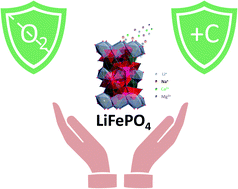Electrochemical lithium recovery with lithium iron phosphate: what causes performance degradation and how can we improve the stability?†
Abstract
Electrochemical processes enable fast lithium extraction, for example, from brines, with high energy efficiency and stability. Lithium iron phosphate (LiFePO4) and manganese oxide (λ-MnO2) have usually been employed as the lithium gathering electrode material. Compared with λ-MnO2, LiFePO4 has a higher theoretical capacity and lower lithium insertion potential but suffers from low performance stability. Therefore, exploring the reason for capacity fading and putting forward an effective approach to address this issue is important. In this work, we studied the effect of additional present cations and dissolved oxygen on the stability of LiFePO4, using a rocking chair cell configuration to eliminate the effect of the other electrode. We found that adding Ca2+ to the solution and dissolved oxygen aggravate the capacity fading of LiFePO4, whereas Na+ and Mg2+ do not show an obvious influence on the stability of LiFePO4. By continuous nitrogen-flushing of the electrolyte and carbon coating of the electrode material, the stability of LiFePO4 was significantly enhanced. The lithium extraction capacity of LiFePO4/C is 21 mgLi gelectrode−1 with an energy consumption of 3.03 ± 0.5 W h molLi−1 and capacity retention of 82% in 10 cycles in 5 mM LiCl + 50 mM NaCl solution at a cell voltage range of −0.5 V to +0.5 V.

- This article is part of the themed collection: 2019 Sustainable Energy and Fuels HOT Articles


 Please wait while we load your content...
Please wait while we load your content...